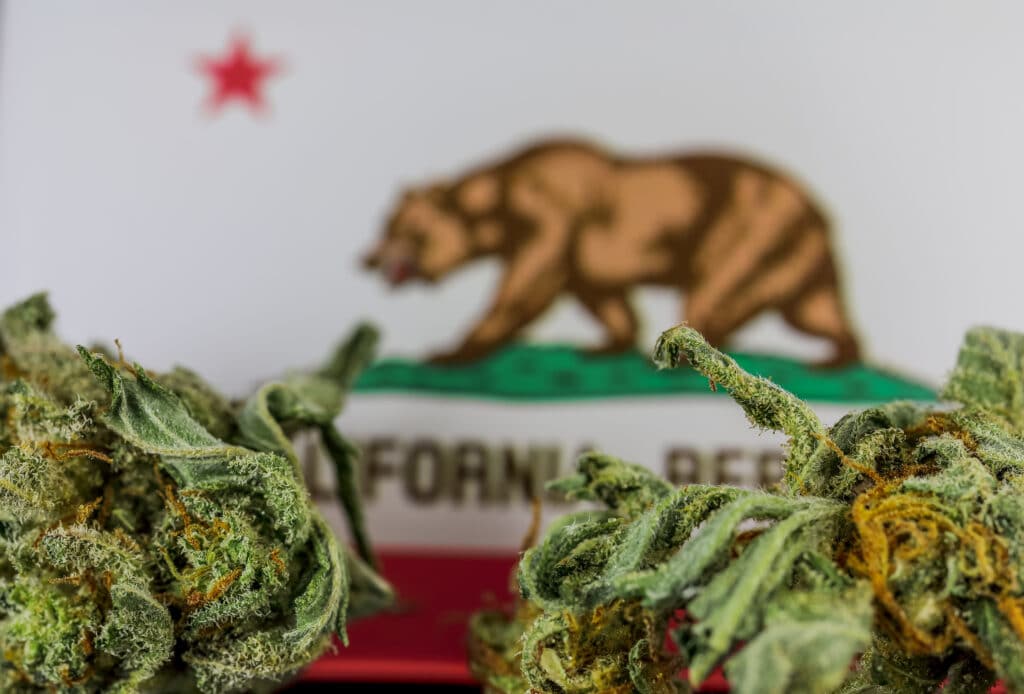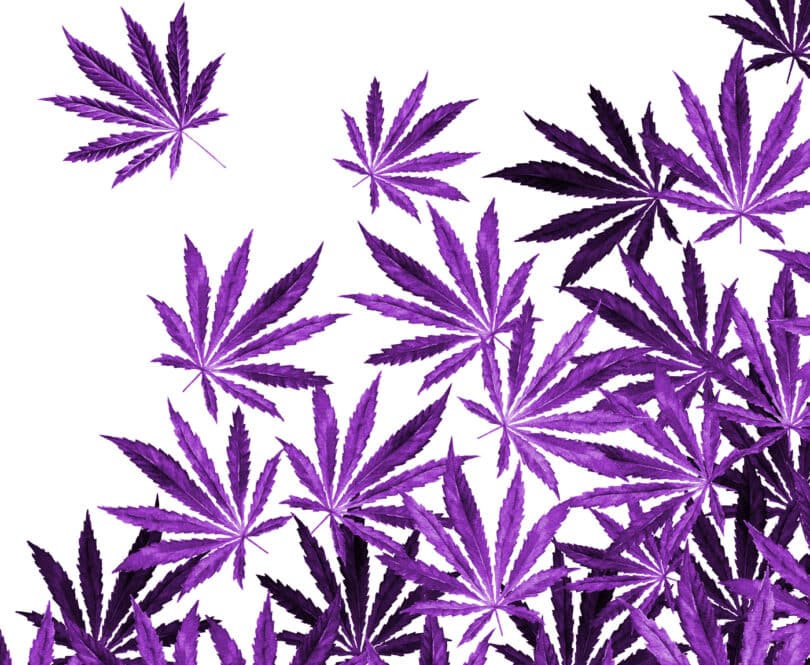If you’ve been keeping up with local news, you probably already know that California’s cannabis industry is facing endless struggles. We’ll get more into the details of how the empire fell here shortly, but one of the biggest problems they’re dealing with is a viroid that has been infecting cannabis crops at an alarming rate. Hop Latent Viroid (HLVd), which results in dudding plants and a substantial loss of revenue, has been a major thorn in the side of many west coast farmers.
Currently, no tangible solution exists, but a group of researchers discovered that purple weed might have some type of resistance to HLVd. It’s a huge breakthrough for both growers, and consumers who might be seeing more lovely purple buds at local dispensaries in the future.
California’s cannabis industry in peril
California has had a difficult go of it in the legal cannabis market. Sure, it’s the largest market in the world with many different dispensaries and product options for consumers to choose from. But behind the scenes, operators are struggling. Starting with statewide pot shortages in the beginning, to a $100 million bailout a couple years ago, ridiculously high taxes and operating costs, insane levels of overproduction during the last couple years that are driving market prices into the dirt, stiff competition from the illicit market, and now, a viroid that’s destroying crops at an alarming rate – it seems like the ‘Golden State’ just can’t seem to get it right.

One thing they do seem to be doing right is attempting to lower taxes, which, keeping in line with California standards, are among the highest in the nation. And this isn’t just a proposal, but an approved legal change implemented at the end of June, 2022, as part of a statewide budget agreement (AB 195). The bill will create a credit tax system, expand labor rights among industry operators, change who collects excise tax, eliminate cultivation tax, and increase enforcement measures against unlicensed operators.
It’s a step in the right direction and certainly a weight off the backs of cannabis cultivators in the state, but it left retailers wondering when they’re going to see some relief. Before the bill was passed, several legislators in industry experts commented about the need for more aid to retailers, who are really feeling the brunt of black-market sales and high overhead costs.
Hop latent viroid
Hop Latent Viroid is the infectious pathogen known for causing “dudding” or “dudding disease” in cannabis plants. A dud crop can be characterized by abnormal branching, poor trichome/resin production, leaf curling, lower potency (decline in THC levels by up to 50 percent), stunted growth, and overall reduced yield. Unfortunately, HLVd can remain asymptomatic, or dormant, in some plants for many years, so it can spread throughout a garden without the grower even knowing that their crops are infected.
“It is possible for the pathogen to enter a production system and spread quietly while never showing any symptoms,” says Joseph Ramahi. “I have seen many plants test positive but show no symptoms, even over time. What appears to happen is a secondary stress occurs (heat/nutritional/pest) during vegetative growth and flowering, at which point 10%-30% of a crop can be lost to dudding.”
“It is also possible that no secondary stress is necessary,” Ramahi added. “It’s possible that with time, even over years, a tipping point is reached and asymptomatic infections become symptomatic as viroid levels in the plants grow.”
Like other viroids, HLVd is transmitted in the following ways – mechanical spread from contaminated tools and equipment, insects like aphids or thrips, and plant to plant transmission – although the extent of which the latter two methods cause disease remains a topic of debate that warrants further research.
Current statistics show that around 90% of cannabis farms in California tested positive for this viroid in some capacity. Most gardens had a 25-50% infection rate, meaning that’s how many of their plants had been exposed.
All about purple pot

Ah, yes… “purple pot”. Who doesn’t love some beautiful purple buds? While the immediately noticeable effects aren’t much different than what you would feel from other strains of similar quality and potency, they do have some amazing flavor profiles and different benefits, for both the purple plant and the humans that consume it.
Just like any other plant in nature, purple cannabis is created by cultivating certain strains in the correct environment. You can’t take any strain, grow it in the cold, and have “purple buds”. You need strains that contain anthocyanins with the predisposition to turn purple, and they need to be exposed to just the right level of cool temps at the correct point in the flowering stage.
The word “anthocyanin” is derived from two Greek words – Anthos meaning Flower and Kyanos meaning blue. Although we typically refer to cannabis with anthocyanins as “purple”, they can actually present in a variety of colors from deep reds to purples and even blue tones. For the sake of simplicity, we will refer to this entire range of colors as “purple”.
Anthocyanins are water-soluble pigment molecules belonging to a larger class of compounds known as Flavonoids. So far, there are over 400 types of anthocyanins that have been identified. They are not found in all plants, but in the ones in which they are present, they occur throughout the entire plant. This includes the leaves stems, roots, flowers, and fruits.
Anthocyanins come from anthocyanidins when excess sugar is produced by the plant, which becomes trapped as nutrient transport slows down. Although this only happens when temperatures drop slightly, sunlight is still a necessity to achieving the vibrant color that anthocyanins are famous for. Freezing temps will destroy the pigment, but when temps are hot or too warm, plants will have excess chlorophyll, giving them those vibrant, green summertime tones.
So, in other words, the conditions need to be just right for anthocyanins to flourish. Cool enough that the purple and blue tones are enhanced without being so cold that the plant dies. Think fall colors – when it’s hot the trees are green but if it’s too cold, the leaves fall off completely. For the beautiful colors, you need to find that sweet spot.
Is purple weed resistant to HLVd?
It would be difficult to give you any hard, fast answer on this, but a team of scientists from the company Medicinal Genomics accidentally discovered that one of their plants was partially resistant to HLVd. And better yet, the flower turns purple as it fights the viroid. The information was provided by Kevin McKernan, scientific director of the institution, at a conference in Florida.

According to McKernan, researchers applied the viroid directly onto cut leaves of the plant, as well as injected one plant, in order to infect them. After six weeks, the plant variety with anthocyanins was still not really infected. And by “not really” infected, I mean that there were detectable levels of HLVd in the plant’s roots, but the leaves and flowers tested negative all the way up to harvest time.
And this was true for both the contact infected and injected plants. The test was repeated 57 times, and continued to test negative every time. “We don’t know why [this is happening]. This could be an immune response, but we’re not seeing this [purple coloring] as heavily increased in the control that’s not infected,” McKernan said.
Final thoughts
The research is minimal, but if it holds true for other purple weed strains, this could be a major breakthrough for cultivators in the golden state who are battling HLVd. Not to mention, it’s not bad for consumers either if farmers start growing more purple flowers.
Hello readers. We’re happy to have you with us at Cannadelics.com; a news source here to bring you the best in independent reporting for the growing cannabis and hallucinogen fields. Join us frequently to stay on top of everything, and subscribe to our Cannadelics Weekly Newsletter, for updates straight to your email. Check out some awesome promos for cannabis buds, smoking devices and equipment like vapes, edibles, cannabinoid compounds, amanita mushroom products, and a whole bunch more. Let’s all get stoned together!









